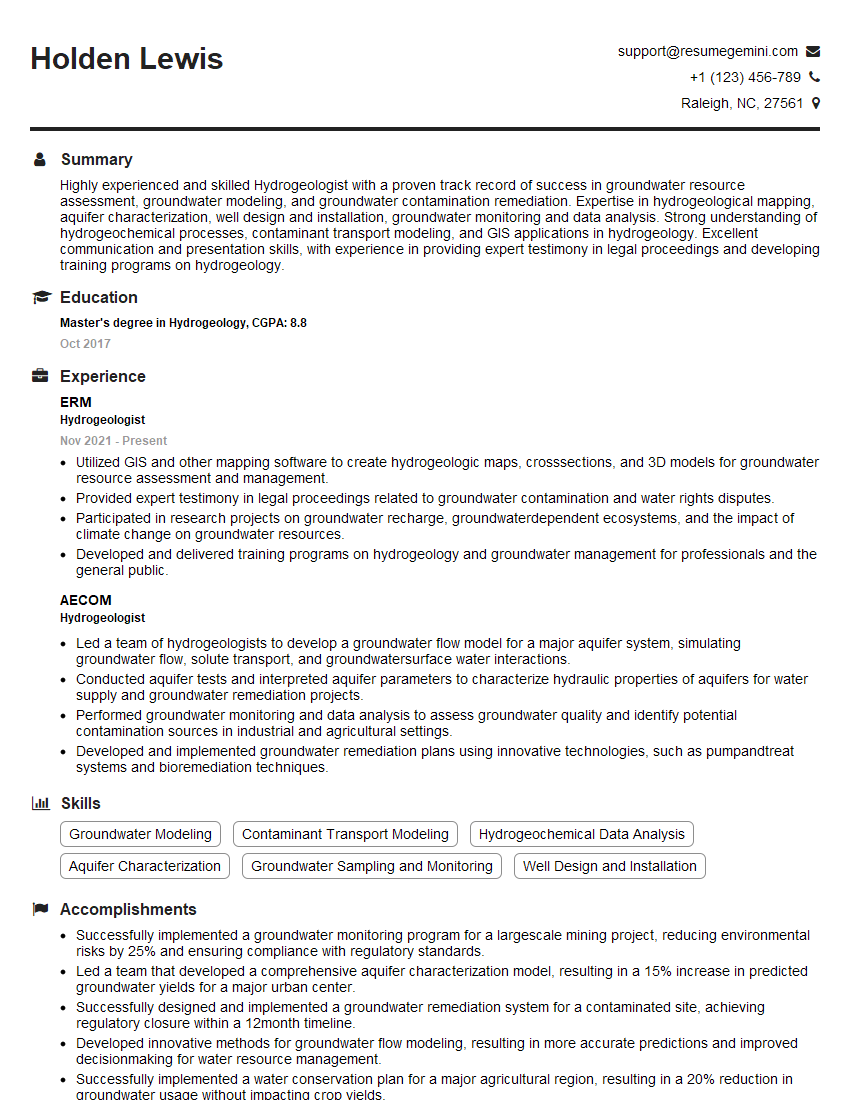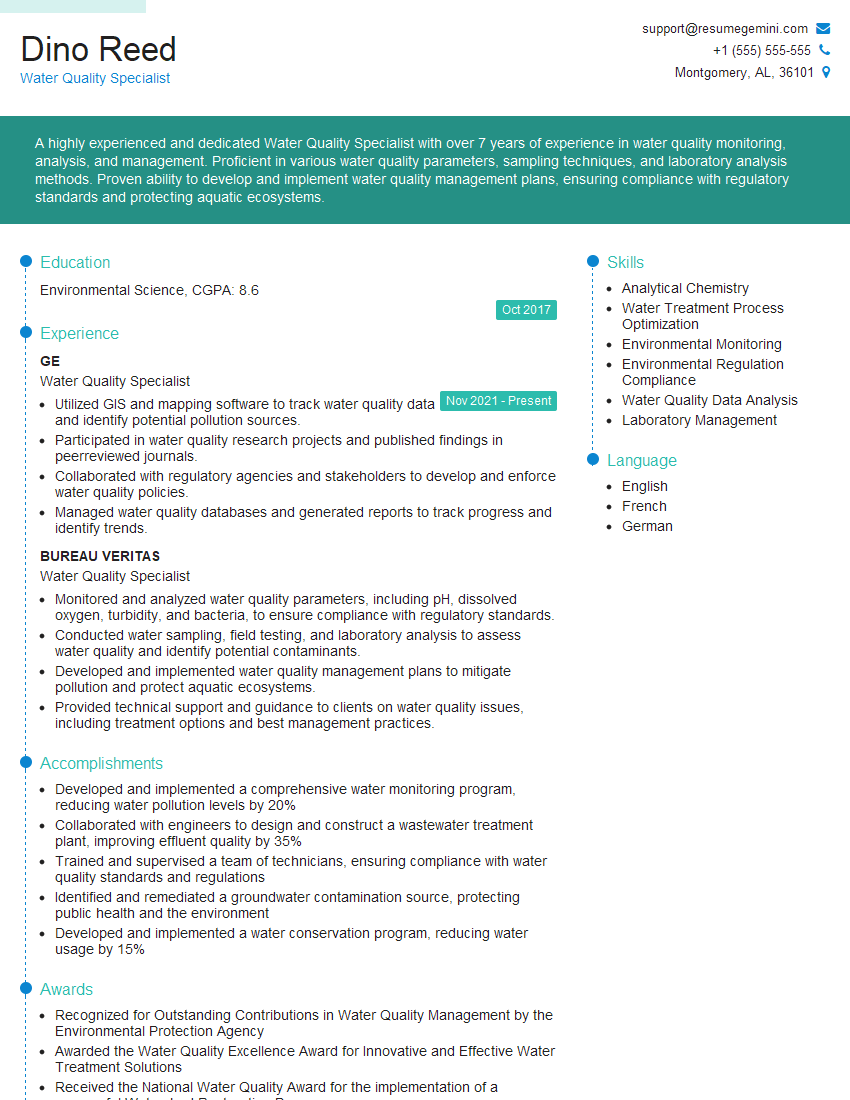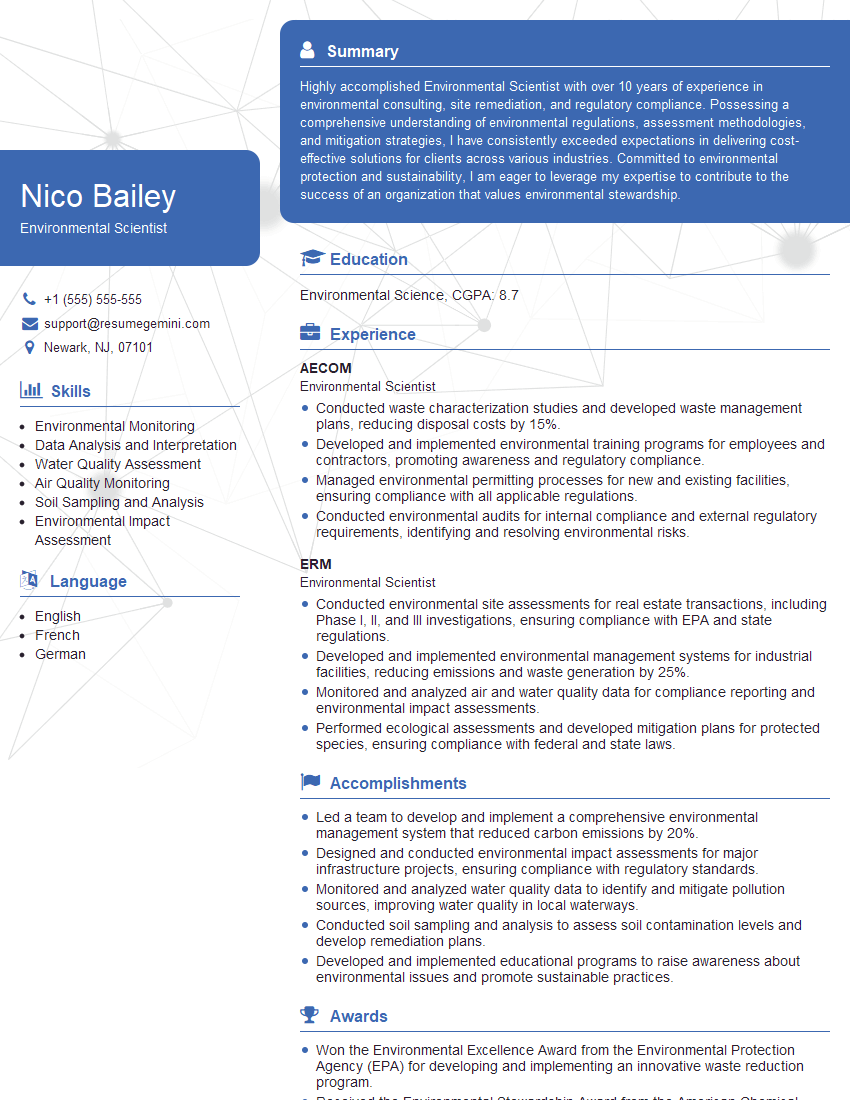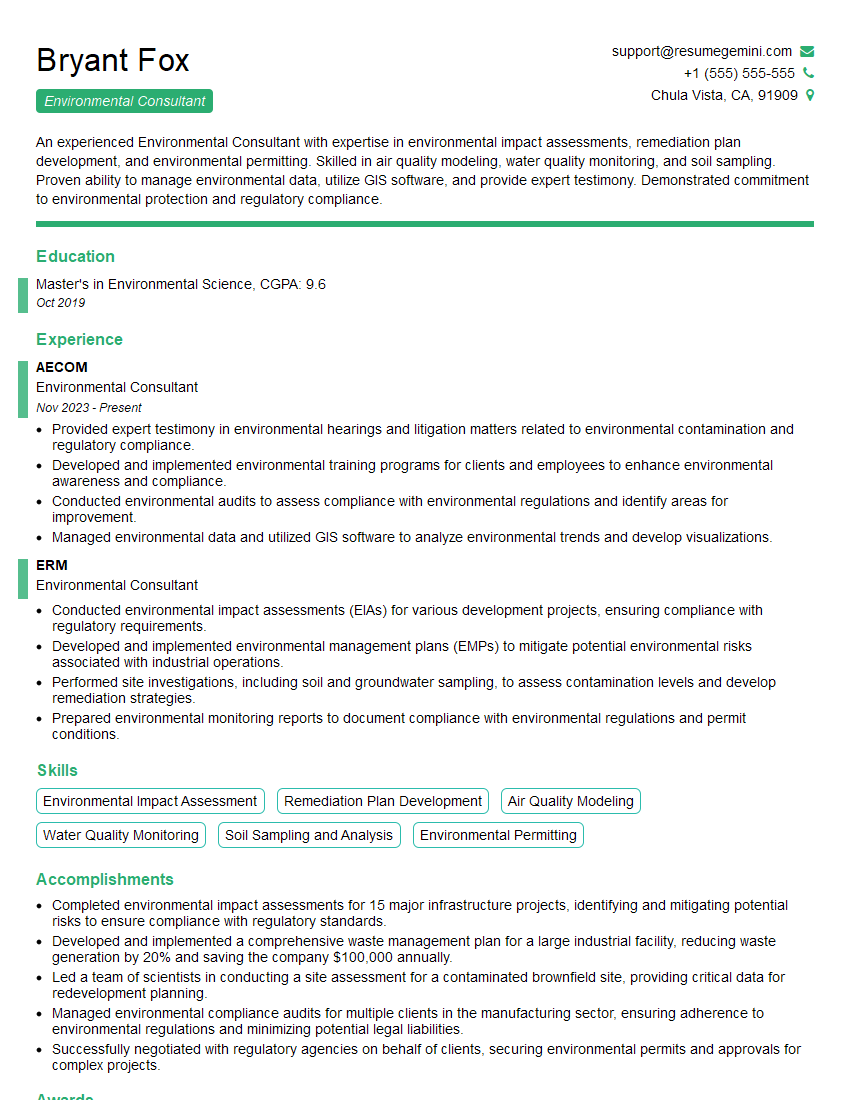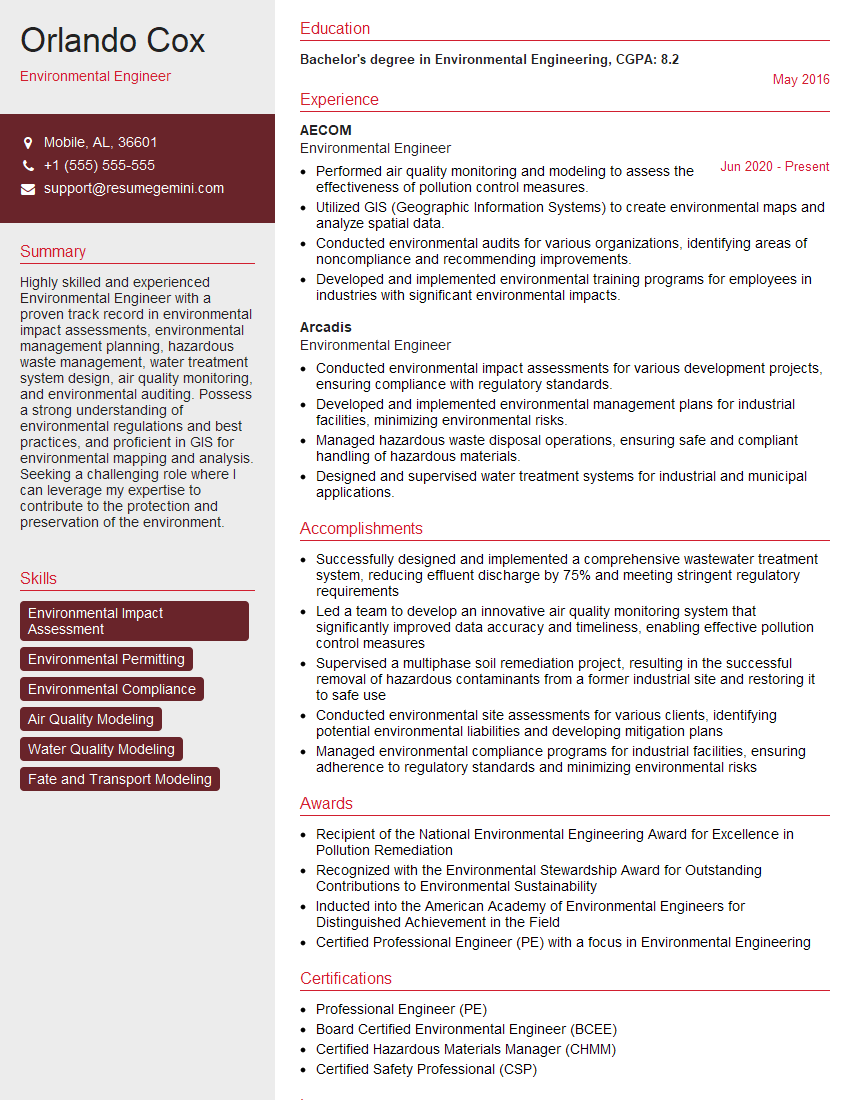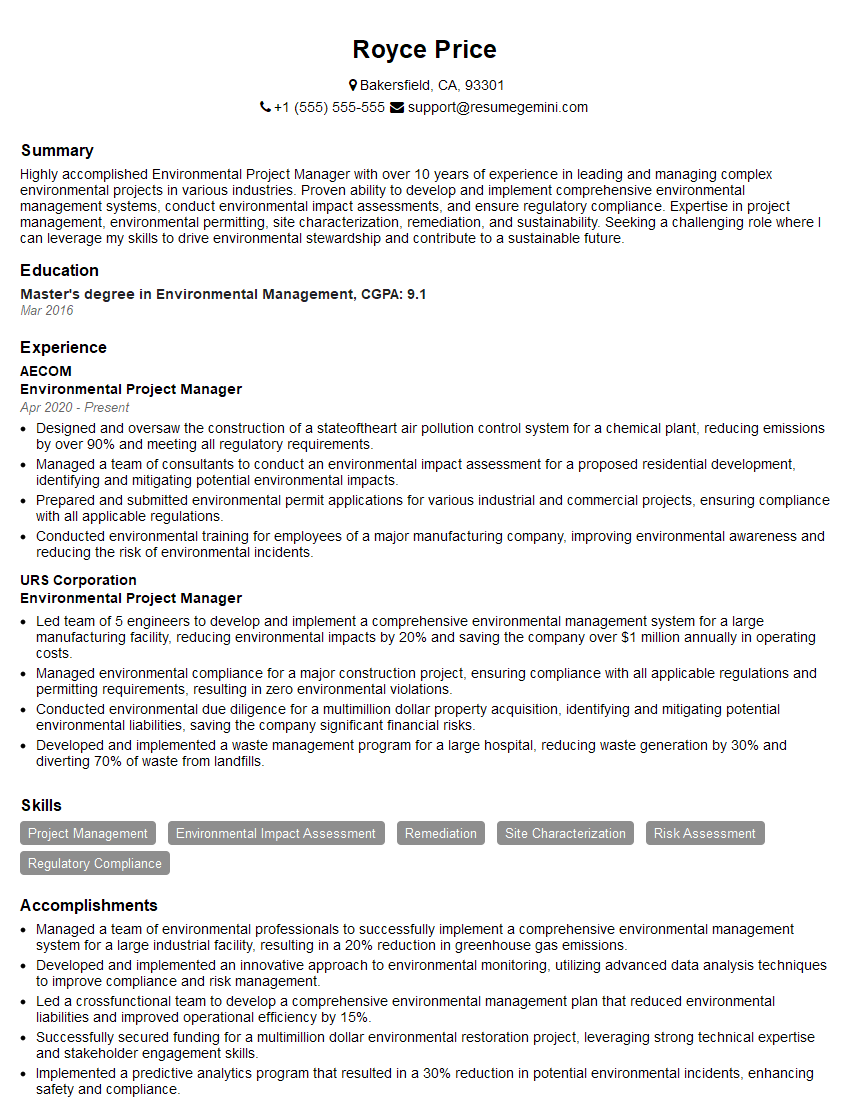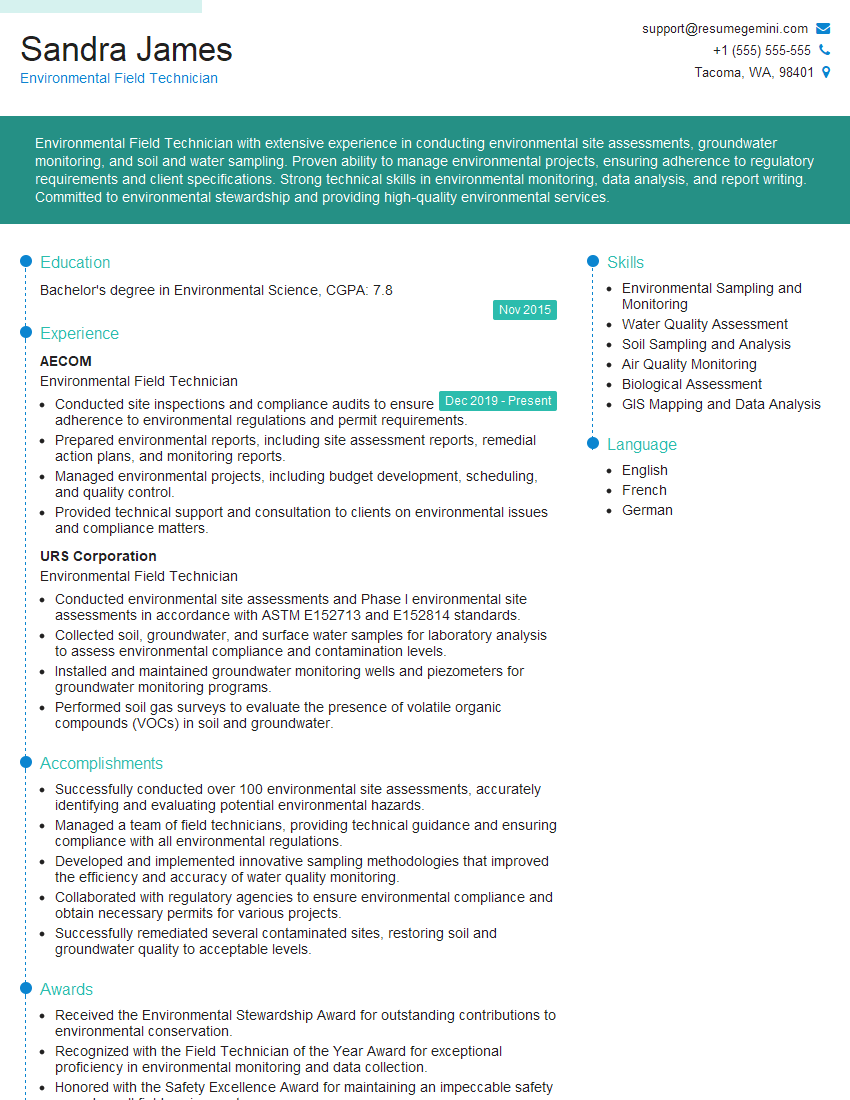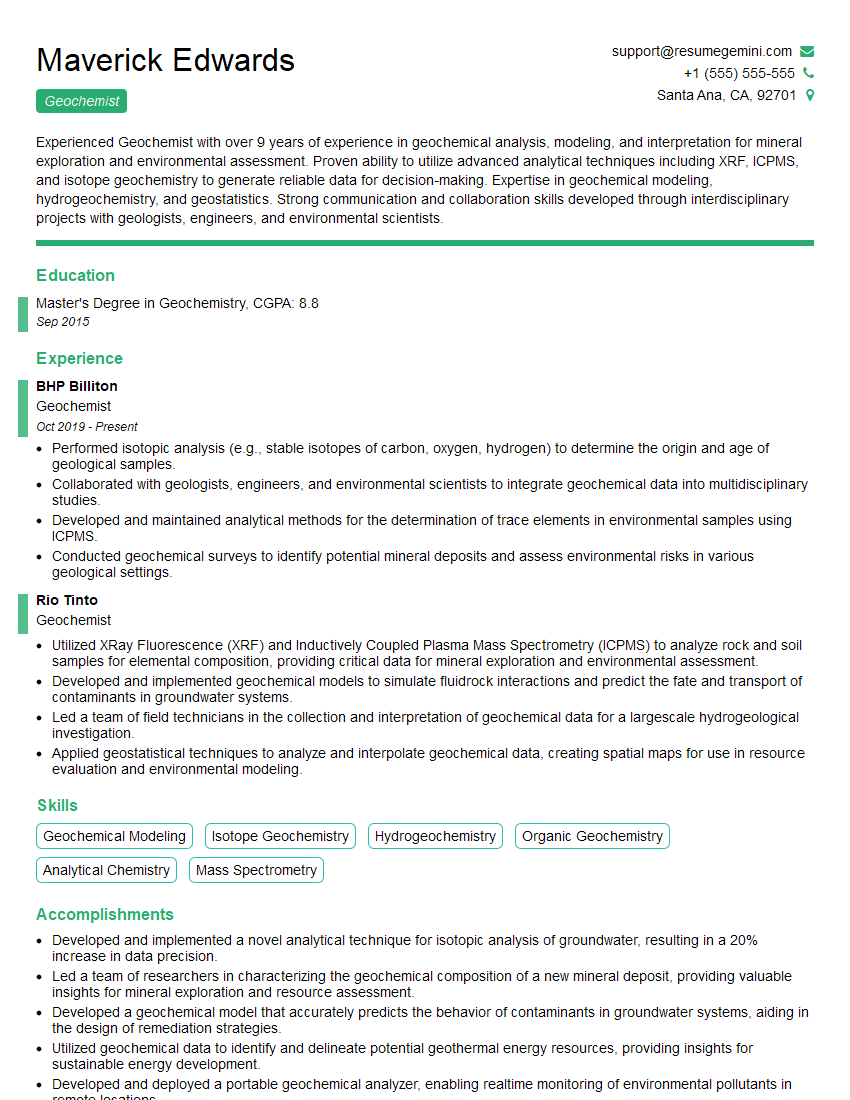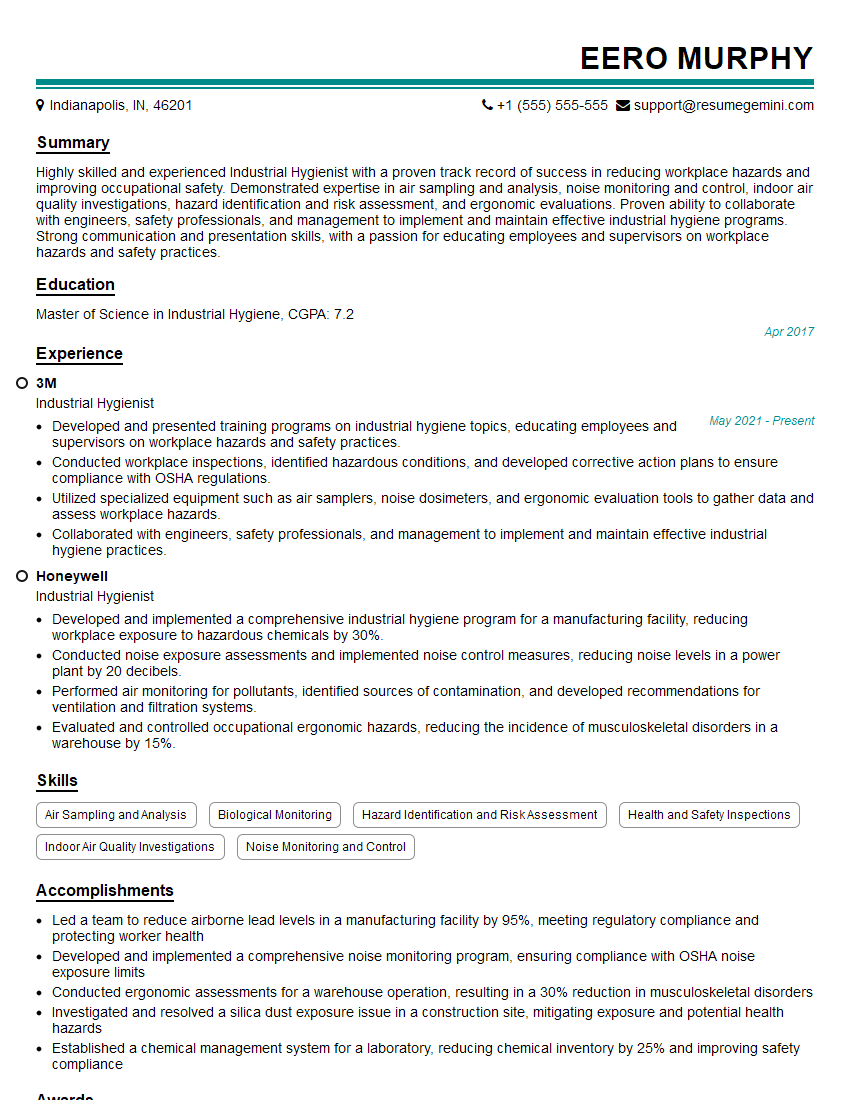Interviews are opportunities to demonstrate your expertise, and this guide is here to help you shine. Explore the essential Environmental field sampling interview questions that employers frequently ask, paired with strategies for crafting responses that set you apart from the competition.
Questions Asked in Environmental field sampling Interview
Q 1. Describe your experience with different types of environmental sampling equipment.
My experience with environmental sampling equipment spans a wide range, encompassing both traditional and advanced technologies. I’m proficient in using a variety of tools depending on the matrix and analyte of interest. For water sampling, this includes everything from simple dippers and grab samplers for surface water to peristaltic pumps for collecting samples at various depths and automated samplers for continuous monitoring. For soil sampling, I’ve extensively used hand augers, soil probes, and even specialized drilling equipment for deeper subsurface sampling. Air sampling involves experience with high-volume samplers for particulate matter, passive samplers for volatile organic compounds (VOCs), and specialized equipment for collecting gaseous samples. I’m also familiar with the use of GPS devices for precise location recording and various field measurement instruments like pH meters, conductivity meters, and turbidity meters to get immediate on-site data.
For example, during a recent project assessing groundwater contamination, we utilized a submersible pump and dedicated sample bottles to collect representative samples from a monitoring well at various depths. The choice of equipment was crucial to ensure the integrity and representativeness of the samples for accurate contaminant analysis.
Q 2. Explain the chain of custody procedures for environmental samples.
Chain of custody (COC) is paramount in environmental sampling to maintain the integrity and legal defensibility of the collected samples. It’s a documented process tracking the sample from collection to analysis, ensuring its handling remains tamper-proof and its identity is preserved. The COC typically includes a unique sample identification number, the date and time of collection, the location, the sampler’s name, the preservation method used, and the date and time of transfer to each subsequent handler (e.g., lab personnel). Each transfer involves signatures and dates, creating a continuous, unbroken trail. Any deviations from the established procedures, including sample contamination or damage, must be documented meticulously.
Think of it like a meticulously kept package delivery receipt. Each step is documented to ensure accountability and prevent any confusion or dispute about the sample’s origin and handling.
Q 3. What are the key considerations for selecting appropriate sampling locations?
Selecting appropriate sampling locations is critical to obtaining representative data. Several factors are considered. First, the objectives of the sampling program determine the location strategy. If assessing a point source of pollution, samples will be collected near the source and at increasing distances to establish a contamination gradient. In contrast, regional-scale assessments might necessitate a spatially stratified random sampling design to account for environmental heterogeneity. Second, accessibility and safety must be considered. It’s crucial to choose locations that are accessible while ensuring the safety of personnel involved, potentially requiring specialized equipment or safety protocols for challenging terrains or hazardous environments.
For instance, in a study of a river’s pollution level, we might use GIS software to create a map and then strategically choose sampling points upstream, downstream, and in the middle to account for the variability of the pollutant’s concentration across the river and its flow.
- Background knowledge: Understanding the site history, potential sources of contamination and prevailing environmental factors.
- Statistical design: Employing appropriate sampling strategies (random, stratified, systematic) for unbiased data.
- Accessibility and safety: Ensuring safe and practical access to selected locations.
Q 4. How do you ensure the accuracy and precision of your field measurements?
Ensuring accuracy and precision in field measurements is a cornerstone of reliable environmental data. This is achieved through a multi-pronged approach starting with proper calibration of all equipment before each sampling event. This includes using certified reference materials to validate instrument readings and maintaining detailed calibration logs. Using appropriate quality control (QC) samples (e.g., field blanks, duplicates, spiked samples) during sampling helps evaluate the accuracy and precision of the sampling and analytical processes. Furthermore, meticulous data recording is crucial to minimize transcription errors and maintain data traceability. Finally, using proper sampling techniques and appropriate sample containers helps reduce sample contamination and ensure sample integrity. For example, using pre-cleaned sample bottles, ensuring appropriate preservatives are added, and preventing cross-contamination.
Imagine baking a cake. If your measuring cups are inaccurate, your cake might not turn out right. Similarly, inaccurate field measurements will lead to unreliable results. Calibration and QC samples are like checking your recipe and equipment to ensure the final product is exactly what you intended.
Q 5. What are the common sources of error in environmental field sampling, and how do you mitigate them?
Several sources of error can affect environmental field sampling. These include contamination (from sample containers, equipment, or the surrounding environment), improper sampling techniques (leading to biased or unrepresentative samples), inaccurate measurements due to malfunctioning instruments or calibration issues, and human errors in sample handling, recording, or analysis. Weather conditions (e.g., rain) can also affect sample integrity and measurement accuracy.
Mitigation strategies involve using clean equipment and containers, employing proper sampling techniques, adhering to strict QC protocols, and careful sample handling, storage, and transportation. Regular equipment calibration, thorough field notes, and proper training of personnel are also critical to reducing errors. For example, we might use field blanks (empty sample containers processed alongside real samples) to detect any potential contamination introduced during the sampling process.
Q 6. Describe your experience with different sampling methods (e.g., grab sampling, composite sampling).
My experience includes various sampling methods tailored to specific objectives. Grab sampling involves collecting a single sample at a specific time and location. It provides a snapshot of conditions at that moment and is suitable when changes in concentrations are not expected. Composite sampling, on the other hand, involves collecting multiple grab samples over a period, mixing them proportionally to obtain a representative sample of the average concentration over the sampling period. This method is useful for assessing average pollutant levels in a system where conditions fluctuate over time.
For instance, when assessing the concentration of a specific pollutant in a wastewater treatment plant, we might utilize composite sampling to get a more representative picture of the pollutant’s concentration over the entire day, unlike a single grab sample that might only reflect conditions during that specific moment.
Q 7. How do you handle contaminated samples and ensure worker safety?
Handling contaminated samples requires adherence to stringent safety protocols to protect both workers and the environment. Personal protective equipment (PPE) such as gloves, respirators, and protective clothing is mandatory. Samples are handled in designated areas using appropriate containment measures, including secondary containment to prevent spills. Decontamination procedures are implemented after sampling, including cleaning and disinfecting all equipment and proper disposal of contaminated materials. Training of personnel on safe handling procedures, emergency response protocols, and the potential health hazards associated with specific contaminants is crucial.
Think of it as handling hazardous materials in a laboratory setting. Detailed safety protocols are followed, including proper training and use of protective gear, to ensure worker safety while minimizing the risk of environmental contamination.
Q 8. What are the regulatory requirements for environmental sampling in your region?
Regulatory requirements for environmental sampling vary significantly depending on location and the specific contaminant being investigated. In my region (which I’ll assume for this interview is a generic US state), we’re primarily guided by federal regulations like the Clean Water Act (CWA), the Clean Air Act (CAA), and the Resource Conservation and Recovery Act (RCRA), as well as state-specific environmental protection agency (EPA) guidelines. These regulations dictate sampling frequencies, methods, and the required analytical parameters for different environmental matrices (soil, water, air). For example, monitoring groundwater near a hazardous waste site would follow stringent RCRA protocols, specifying well installation, sampling techniques, and the list of analytes to test for, ensuring proper chain of custody documentation throughout the process. Similarly, monitoring air quality for particulate matter would adhere to the CAA, mandating specific sampling equipment, quality control measures, and reporting requirements. Non-compliance can lead to significant penalties and legal repercussions. It’s crucial to stay updated on any changes or amendments to these regulations.
Q 9. How do you interpret environmental data collected in the field?
Interpreting environmental data involves a multi-step process that begins with data validation and quality control checks. I verify the accuracy and completeness of the data, identifying any outliers or anomalies that might indicate issues during sampling or laboratory analysis. Then, I analyze the data using statistical methods and compare the results against regulatory limits or background concentrations for the specific location and medium. For instance, if we’re analyzing soil samples for heavy metals, I would use descriptive statistics (mean, median, standard deviation) to summarize the data and compare these values with established soil screening levels or background concentrations for the area to determine if contamination exists. Visualization techniques like graphs and maps also play a vital role, enabling identification of spatial patterns and trends in contamination. Finally, I’d prepare a comprehensive report explaining the findings, uncertainties, and the implications of the results, which may include recommending further investigation or remediation measures.
Q 10. Explain your experience with data logging and data management in field sampling.
My experience with data logging and management in field sampling is extensive. I utilize both handheld devices and software for data collection and management. In the field, I use ruggedized tablets or hand-held computers with pre-programmed data entry forms to ensure consistency and minimize errors. This software is typically linked to GPS devices, enabling accurate georeferencing of samples. Upon returning to the lab, the data is downloaded and reviewed, checked for completeness and any potential errors. I often use database software (such as Access or ArcGIS) for organizing and managing the collected data, maintaining a comprehensive chain of custody for each sample, from collection through laboratory analysis and reporting. This includes detailed information such as sample location, date and time of collection, sampling method, and sample ID. Data quality assurance/quality control (QA/QC) protocols are strictly followed during all stages to ensure the reliability and integrity of the data.
Q 11. How do you maintain the integrity of samples during transportation and storage?
Maintaining sample integrity during transportation and storage is paramount to ensuring reliable results. My approach involves several key steps. First, appropriate sample containers are chosen based on the sample type and analyte, with careful consideration given to preventing contamination and preserving sample stability. For instance, water samples are typically collected in pre-cleaned glass or plastic bottles, and soil samples are collected in sealed bags or containers. Second, samples are properly labeled and documented, maintaining a clear chain of custody throughout the process. This often involves barcodes, unique identifiers and sealed tamper-evident containers. Third, samples are transported under appropriate temperature and light conditions to minimize degradation. Refrigerated transportation is often needed for certain analytes. Fourth, samples are stored at prescribed temperatures (e.g., refrigeration or freezing) to prevent degradation, and stored in appropriate conditions to minimize cross contamination.
Q 12. Describe your proficiency in using GPS and GIS for environmental sampling.
I’m highly proficient in using GPS and GIS for environmental sampling. I use handheld GPS units to accurately record the geographical coordinates of each sampling location. This data is then integrated into a GIS (Geographic Information System) software such as ArcGIS. Within the GIS environment, I can create maps to visualize sampling locations, environmental data, and other relevant spatial information. I leverage the power of GIS to identify spatial trends in contamination, design efficient sampling strategies (e.g., optimizing the location of sampling points to minimize sampling bias), overlay environmental data with other data layers (like land use or geology) for better interpretation, and to create compelling visualizations for reports and presentations. One project involved mapping groundwater contamination plumes, which required precise GPS location data and GIS analysis to effectively delineate the extent of contamination and inform remediation efforts.
Q 13. How do you identify and address potential sampling biases?
Identifying and addressing sampling biases is crucial for ensuring the reliability of environmental data. Several biases can creep into sampling, including: temporal bias (choosing inappropriate times of the day or year), spatial bias (selecting locations that aren’t representative of the entire area), and methodological bias (improper use of sampling equipment or techniques). To mitigate these biases, I employ several strategies. Firstly, I ensure a statistically sound sampling design, carefully selecting the number and location of sampling points to represent the population of interest. Secondly, I adhere strictly to standardized sampling protocols and quality assurance/quality control (QA/QC) measures. Thirdly, I utilize random sampling techniques where possible to reduce human influence on sample selection. Lastly, I use statistical methods to assess the potential impact of biases on the overall results. For example, if we observe a clear spatial trend in contaminant levels, we’d investigate potential reasons and may need to adjust our sampling strategy to better represent the variability. Proper documentation and a thorough description of the sampling methodology in reports helps ensure transparency and allows for critical evaluation of potential biases by others.
Q 14. What are the limitations of different sampling methods?
Different sampling methods have inherent limitations. For instance, grab sampling (collecting a single sample at a point in time) can miss temporal variations in contaminant concentrations, while composite sampling (mixing multiple samples) can mask spatial variations. Groundwater sampling can be challenging due to the heterogeneity of aquifers and the difficulty of accessing representative groundwater. Air sampling can be affected by meteorological conditions, and the choice of sampling equipment significantly affects the accuracy and precision of air quality measurements. Similarly, soil sampling is influenced by the variability of soil properties and the potential for preferential flow pathways. Choosing the appropriate method requires careful consideration of the specific research question, the environmental matrix, the target analyte, the budget, and the inherent uncertainties associated with each method. Knowing these limitations allows for a more robust and informed interpretation of collected data, and the limitations are always explicitly discussed in any report.
Q 15. How do you ensure compliance with safety regulations during field sampling?
Safety is paramount in environmental field sampling. My approach is multifaceted, starting with a thorough risk assessment before any fieldwork. This involves identifying potential hazards – chemical exposure, slips, trips, falls, wildlife encounters, extreme weather – specific to the site and sampling method. We then develop a Site-Specific Health and Safety Plan (SSHP) detailing the necessary precautions. This plan includes selecting appropriate Personal Protective Equipment (PPE), such as safety boots, gloves, respirators, and high-visibility clothing, based on the identified risks.
Furthermore, we conduct thorough training for all team members, ensuring everyone understands the SSHP and their individual responsibilities. We also implement strict adherence to procedures, including buddy systems, regular check-ins, and emergency communication protocols. For instance, on a recent project involving potentially contaminated soil, we employed a two-person team, with one acting as a spotter to ensure the other was following proper handling techniques and observing safety protocols. Regular safety briefings were conducted at the start of each workday, reinforcing safe practices and adapting to any changing conditions.
Finally, comprehensive documentation is maintained, including daily safety logs and incident reports, crucial for demonstrating compliance and identifying areas for improvement. We understand that proactive safety measures are not just a legal requirement but also essential for protecting our team and ensuring the integrity of our data.
Career Expert Tips:
- Ace those interviews! Prepare effectively by reviewing the Top 50 Most Common Interview Questions on ResumeGemini.
- Navigate your job search with confidence! Explore a wide range of Career Tips on ResumeGemini. Learn about common challenges and recommendations to overcome them.
- Craft the perfect resume! Master the Art of Resume Writing with ResumeGemini’s guide. Showcase your unique qualifications and achievements effectively.
- Don’t miss out on holiday savings! Build your dream resume with ResumeGemini’s ATS optimized templates.
Q 16. Describe your experience with field data validation and quality control.
Data validation and quality control are integral to ensuring the reliability of environmental data. My experience encompasses the entire data lifecycle, from sample collection to final reporting. It begins in the field with meticulous documentation – chain of custody forms, sample labels, field notes detailing location, time, and observations. In the laboratory, we implement rigorous quality control procedures using blanks, duplicates, and spiked samples to assess accuracy and precision. This allows for the early detection of contamination or analytical errors.
For example, when analyzing water samples for heavy metals, we use method blanks to detect contamination introduced during sample preparation or analysis. Duplicate samples assess the precision of our analytical techniques. Spiked samples help ascertain the accuracy of the method. The results are then subjected to statistical analysis to check for outliers and assess the overall data quality. Any anomalies are investigated thoroughly, potentially requiring re-sampling or further analysis. I am proficient in utilizing quality assurance/quality control (QA/QC) software to manage and track this data, generating reports that clearly document the QA/QC process and highlight any potential issues.
Data validation extends to checking for inconsistencies between field and lab data, ensuring that the data meets the project-specific requirements and regulatory standards. Ultimately, robust QA/QC processes ensure the data’s reliability and defensibility, building confidence in the resulting environmental assessments.
Q 17. How do you deal with unexpected problems or challenges during field sampling?
Unexpected challenges are inevitable in field sampling. My approach emphasizes preparedness and problem-solving. Before heading into the field, we develop contingency plans, addressing potential issues such as equipment failure, adverse weather, or site access restrictions. For example, we always carry backup equipment and have alternative transportation options. If unforeseen issues arise, the first step is to assess the situation’s impact on data quality and safety.
Let’s say a critical piece of sampling equipment malfunctions. We would first try to troubleshoot it. If that’s not possible, we’d evaluate the effect on the project timeline and data integrity. We might need to make adjustments, such as using an alternative sampling method or focusing on a subset of the planned sampling locations. Detailed documentation of any deviation from the original plan is crucial. We always prioritize safety – if conditions become too unsafe, the sampling is postponed.
Communicating effectively is crucial, particularly with supervisors and stakeholders, to manage expectations and ensure timely corrective action. The goal is to mitigate the impact of the challenge while maintaining data quality and adhering to safety protocols. Regular post-project reviews help us learn from these unexpected problems and refine our procedures for future projects.
Q 18. What software or tools do you use to analyze environmental data?
I utilize a range of software and tools for environmental data analysis, depending on the specific project requirements. For data management and QA/QC, I’m proficient in LIMS (Laboratory Information Management Systems) software, which helps track samples, manage results, and ensure data integrity. For statistical analysis, I use R and its various packages (e.g., ggplot2 for visualization, stats for statistical tests) to explore relationships between variables and conduct hypothesis testing.
GIS software, such as ArcGIS, is integral to visualizing spatial data and performing spatial analysis, particularly crucial when dealing with geographically distributed environmental samples. Specialized software packages, such as those designed for specific pollutants or matrices (e.g., heavy metal analysis or groundwater modeling), are used as needed. Finally, spreadsheet software like Microsoft Excel is used for data entry, basic calculations, and preparing initial reports. The specific tools and software employed are always selected based on the nature of the data and the analytical objectives of the project.
Q 19. Explain your understanding of different types of environmental matrices (soil, water, air).
Environmental matrices refer to the different types of media in which environmental contaminants can be found. Understanding the characteristics of each matrix is critical for selecting appropriate sampling and analytical methods.
- Soil: Soil is a complex mixture of mineral particles, organic matter, water, and air. Its composition varies greatly depending on factors such as climate, geology, and vegetation. Sampling considerations include soil type, depth, and heterogeneity. Contamination can be adsorbed onto soil particles, making extraction techniques critical.
- Water: Water matrices can include surface water (rivers, lakes, oceans), groundwater, and wastewater. Sampling needs vary depending on the water body’s characteristics (e.g., flow rate, depth, turbidity) and the target contaminants. Maintaining the sample’s integrity, preventing contamination, and preserving the sample’s physical and chemical characteristics are essential.
- Air: Air sampling is particularly challenging due to the dynamic nature of air and the potential for rapid contaminant dispersion. Sampling methods vary widely, ranging from passive samplers (e.g., diffusive samplers) to active samplers (e.g., high-volume samplers). Careful consideration needs to be given to the target contaminants’ properties, including volatility and reactivity.
The selection of appropriate sampling and analytical methods is dictated by the specific characteristics of the matrix and the target contaminants. For instance, the method for sampling volatile organic compounds (VOCs) in soil will differ significantly from that for heavy metals in water.
Q 20. Describe your experience with specific sampling techniques for soil, water, or air.
My experience encompasses a wide range of sampling techniques for different environmental matrices. For soil, I’m proficient in various methods, including:
- Grab sampling: Collecting soil samples at specific points using a shovel or auger. This is suitable for preliminary assessments or when heterogeneity is low.
- Composite sampling: Combining several grab samples from a defined area to represent the average soil composition. This reduces variability but masks spatial heterogeneity.
- Stratified sampling: Dividing the area into strata based on soil properties and collecting samples from each stratum. This method is used when heterogeneity is high and representative sampling is crucial.
For water, techniques include:
- Grab sampling: Collecting a single sample at a specific time and location. This is quick but may not represent the overall water quality.
- Integrated sampling: Using a sampler that collects water from different depths, providing a more representative sample. This is crucial for water bodies with vertical stratification.
- Continuous monitoring: Using automated equipment to continuously monitor water quality parameters. This is particularly valuable for studying temporal variations in water quality.
Air sampling methods I have employed include using high-volume samplers equipped with filters to collect particulate matter, and specialized canisters for collecting gaseous contaminants. The choice of sampling technique always depends on the project objectives, the target contaminant, and the characteristics of the environmental matrix.
Q 21. How do you determine the appropriate sample size and number of replicates?
Determining the appropriate sample size and number of replicates is crucial for ensuring the reliability and statistical power of environmental studies. This decision involves several considerations.
- Project Objectives: The level of detail and the precision needed will influence sample size. A broader screening study may require fewer samples than a detailed site investigation.
- Spatial Variability: The heterogeneity of the site plays a major role. Highly variable sites require more samples to capture the range of variability. For instance, a heterogeneous soil site might need more samples than a homogeneous one.
- Target Contaminant: The expected concentration of the contaminant influences sample size. For low-concentration contaminants, more samples might be necessary to detect them reliably.
- Statistical Power: The desired confidence level and power of the statistical analysis also dictate the sample size. Larger sample sizes provide greater power to detect significant differences or relationships.
- Resources and Budget: Practical considerations, including time and budget constraints, also influence the decision-making process.
Statistical power calculations, using software or specialized statistical tables, can help determine the necessary sample size. Replicates are essential to assess variability and improve the reliability of the results. The number of replicates depends on the desired level of precision and the inherent variability of the sampling location. A balance must be struck between the desired accuracy, the resources available, and the need to capture meaningful spatial variation.
Q 22. How do you document and report your field sampling activities?
Meticulous documentation is the cornerstone of reliable environmental field sampling. My approach involves a multi-layered system ensuring data integrity and traceability. It begins with a detailed sampling plan outlining the objectives, location, methods, and parameters. This plan acts as a roadmap for the entire process.
During fieldwork, I maintain a comprehensive field notebook, recording every step: date, time, location coordinates (using GPS), weather conditions, sample ID numbers, equipment used, any deviations from the plan, and observations about the site. Photographs and videos are crucial for visual documentation, providing context and verifying the sampling process. All data entries are legible and signed.
Upon returning to the lab, I meticulously transfer all field data into a digital database, typically using a LIMS (Laboratory Information Management System). This ensures data security and efficient analysis. The final report includes all raw data, chain of custody documentation, QA/QC procedures, and interpretations of the results. For example, if I’m sampling soil for heavy metals, I meticulously record the depth and location of each sample, along with any visible signs of contamination. Any discrepancies or anomalies are flagged and explained. This rigorous documentation allows for audits and ensures the credibility of the findings.
Q 23. Describe your experience with health and safety protocols in field sampling.
Health and safety are paramount in environmental field sampling. My experience encompasses a wide range of protocols, from basic personal protective equipment (PPE) usage to managing hazardous materials and responding to emergencies. I’m proficient in the safe handling of chemicals, including proper dilution, disposal, and spill response procedures.
Before each fieldwork, I meticulously review the site-specific risk assessment, which includes identifying potential hazards like exposure to toxins, sharp objects, or unstable terrain. This risk assessment informs the selection of appropriate PPE, such as gloves, respirators, safety glasses, and high-visibility clothing. I’m trained in first aid and CPR and always carry a well-stocked first-aid kit.
On several occasions, I’ve had to adapt safety protocols based on unexpected findings. For instance, during a groundwater sampling project, we encountered unexpectedly high levels of methane gas. We immediately halted the sampling, implemented ventilation procedures, and contacted the safety officer before resuming operations with modified safety measures. This proactive approach to safety ensures both personal wellbeing and the integrity of the data collected.
Q 24. What is your experience with field equipment calibration and maintenance?
Regular calibration and maintenance of field equipment is essential for accurate and reliable data. My experience includes calibrating and maintaining a variety of equipment, including pH meters, conductivity meters, water samplers, and GPS units. I follow manufacturer’s instructions and maintain detailed calibration logs, ensuring traceability of measurements.
For instance, before every groundwater sampling event, I meticulously calibrate the water level meter and the water quality sensors. This involves using certified calibration standards and recording the results in a dedicated logbook. I also perform routine maintenance, such as cleaning and replacing sensors, to ensure optimal performance. Any issues or repairs are documented and reported to the appropriate personnel. A well-maintained instrument, like a properly calibrated pH meter, is crucial for accurate measurement of soil or water acidity, providing dependable data for environmental assessments.
Furthermore, I am familiar with the use of calibration verification software and generating reports for regulatory purposes.
Q 25. How do you manage field logistics, including sample transport and storage?
Efficient field logistics are crucial for successful sampling. My experience involves meticulous planning and execution, covering sample collection, transport, and storage. This begins with creating a detailed sampling schedule and ensuring appropriate transportation of personnel and equipment to remote locations if needed.
Sample handling is done according to chain-of-custody protocols, using tamper-evident seals and properly labelled containers. I maintain a comprehensive tracking system, logging the location, date, time, and condition of each sample. Appropriate storage methods are crucial – some samples require refrigeration, while others may need freezing or preservation with chemicals. For example, water samples for microbiological analysis need to be kept at 4°C immediately after collection. For volatile organic compounds, special headspace vials are used to prevent loss of the target compounds.
I have experience in managing the shipping and receiving of samples to the lab, ensuring adherence to all transportation regulations and ensuring samples arrive in optimal condition. Proper documentation throughout this entire chain ensures data integrity.
Q 26. What types of permits or approvals are needed for environmental field sampling?
The regulatory environment surrounding environmental sampling varies significantly depending on the location, the type of sample, and the purpose of the sampling. I’m well-versed in navigating this complex landscape.
Generally, permits or approvals are required from relevant environmental agencies. These permits might cover accessing private land, disturbing protected habitats, collecting endangered species, or discharging wastewater. Obtaining these permits requires thorough application processes, often involving detailed sampling plans, risk assessments, and proof of liability insurance.
For example, when sampling near wetlands or other sensitive ecosystems, obtaining permits under the Clean Water Act (CWA) or similar legislation is often essential. The specific requirements for each permit will vary, requiring close attention to detail during the application process and ongoing compliance throughout the project. Ignoring these regulatory requirements can lead to significant penalties.
Q 27. Describe your experience working independently and as part of a team in the field.
I’m comfortable working both independently and as part of a team. Independent work requires strong self-motivation, resourcefulness, and problem-solving skills. I’ve often conducted solo sampling events in remote locations, relying on my training and experience to overcome challenges like equipment malfunctions or unexpected weather conditions. For example, I once had to troubleshoot a malfunctioning GPS device in a remote forest using my backup compass and map, successfully completing my field work.
Teamwork is equally important. In larger projects, collaboration and effective communication are crucial. I’m adept at coordinating tasks, sharing information, and contributing to a positive team dynamic. I’ve successfully participated in numerous multidisciplinary teams, working alongside hydrologists, geologists, and other environmental professionals. This collaborative approach fosters a deeper understanding of the environment being studied, leading to more robust data and informed conclusions.
Q 28. How do you stay current with changes and advances in environmental sampling techniques?
Staying current in the dynamic field of environmental sampling requires continuous learning and professional development. I actively participate in professional organizations like the American Chemical Society (ACS) and attend conferences, workshops, and training sessions to learn about new techniques and technologies.
I also regularly review peer-reviewed scientific journals and industry publications. This keeps me abreast of advances in analytical methods, data management software, and best practices for environmental sampling. Online resources, webinars, and specialized training programs provide a wealth of knowledge. For instance, I recently completed a course on the emerging technique of passive sampling for persistent organic pollutants.
Staying up-to-date allows me to continually improve my skills, ensuring I employ the most accurate, efficient, and environmentally responsible methods. Adapting to new technologies and methodologies is critical for providing high-quality, reliable environmental data.
Key Topics to Learn for Environmental Field Sampling Interview
- Sampling Design and Methodology: Understanding different sampling strategies (e.g., random, stratified, systematic), sample size determination, and the impact of bias on data quality. Practical application: Designing a sampling plan for soil contamination assessment at a former industrial site.
- Sample Collection Techniques: Mastering proper procedures for collecting various environmental samples (water, soil, air, biological) while maintaining chain of custody and minimizing contamination. Practical application: Describing the steps involved in collecting a water sample for pesticide analysis, including preservation and labeling.
- Field Instrumentation and Equipment: Familiarity with common field instruments (e.g., pH meters, conductivity meters, GPS devices, data loggers) and their calibration, operation, and maintenance. Practical application: Troubleshooting a malfunctioning water level sensor during a groundwater monitoring event.
- Health and Safety Protocols: Understanding and adhering to relevant safety regulations and procedures for working in various field environments, including personal protective equipment (PPE) and emergency response. Practical application: Explaining the safety measures needed when collecting samples from a contaminated site.
- Data Management and Analysis: Proper record-keeping, data entry, and basic data analysis techniques for environmental data. Practical application: Describing how to organize and interpret field data to assess the extent of a pollutant plume.
- Regulatory Compliance: Understanding relevant environmental regulations and reporting requirements. Practical application: Explaining the process of submitting environmental data to a regulatory agency.
- Quality Assurance/Quality Control (QA/QC): Implementing QA/QC measures to ensure data accuracy and reliability. Practical application: Describing the use of field blanks and duplicates in environmental sampling.
Next Steps
Mastering environmental field sampling techniques is crucial for a successful and rewarding career in environmental science. Strong proficiency in this area opens doors to diverse and impactful roles within the field. To maximize your job prospects, it’s essential to create a compelling and ATS-friendly resume that showcases your skills and experience effectively. We recommend using ResumeGemini to build a professional and impactful resume. ResumeGemini provides tools and resources to create a resume that stands out, and examples of resumes tailored to Environmental field sampling are available to help guide you.
Explore more articles
Users Rating of Our Blogs
Share Your Experience
We value your feedback! Please rate our content and share your thoughts (optional).
What Readers Say About Our Blog
Hi, I have something for you and recorded a quick Loom video to show the kind of value I can bring to you.
Even if we don’t work together, I’m confident you’ll take away something valuable and learn a few new ideas.
Here’s the link: https://bit.ly/loom-video-daniel
Would love your thoughts after watching!
– Daniel
This was kind of a unique content I found around the specialized skills. Very helpful questions and good detailed answers.
Very Helpful blog, thank you Interviewgemini team.
